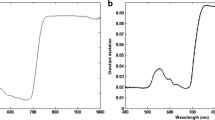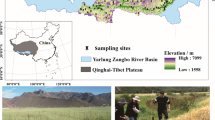Abstract
Estimating leaf chlorophyll contents through leaf reflectance spectra is efficient and nondestructive, but the actual dataset always based on a single or a few kinds of specific species, has a limitation and instability for a common use. To address this problem, a combination of multiple spectral indices and a model simulated dataset are proposed in this paper. Six spectral indices are selected, including Blue Green Index (BGI), Photochemical Reflectance Index (PRI_5), Triangle Vegetation Index (TVI), Chlorophyll Absorption Ratio Index (CARI), Carotenoid Reflectance Index (CRI) and the green peak reflectance (R525). Both stepwise linear regression (SLR) and back-propagation artificial neural network (ANN) are used to combine the six spectral indices for the estimation of chlorophyll content (Cab). In addition, to overcome the limitation of actual dataset, a “big data” is applied by a within-leaf radiation transfer model (PROSPECT) to generate a large number of simulated samples with varying biochemical and biophysical parameters. 30% of the simulated dataset (SIM30) and an experimental dataset are used for validation. Compared with linear regression method, NN yields better result with R2 = 0.96 and RMSE = 5.80ug.cm−2 for Cab if validated by SIM30, while R2 = 0.95 and RMSE = 6.39ug.cm−2 for SLR. NN also gives satisfactory result with R2 = 0.80 and RMSE = 5.93ug.cm−2 for Cab if validated by LOPEX dataset, however, the SLR only gets 0.72 of R2 and 12.20ug.cm−2 of RMSE. The results indicate that integrating multiple spectral indices can improve the Cab estimating accuracy with a better stability in different kind of species and the model simulated dataset can make up the shortfall of actual measured dataset.







Similar content being viewed by others
Change history
15 September 2017
An erratum to this article has been published.
References
Aber JD, Federer CA (1992) A generalized, lumped-parameter model of photosynthesis, evapotranspiration and net primary production. Oecologia 92:463–474. https://doi.org/10.1007/BF00317837
Bacour C, Baret F, Béal D, Weiss M, Pavageau K (2006) Neural network estimation of LAI, fAPAR, fCover and LAI×cab, from top of canopy MERIS reflectance data: principles and validation. Remote Sens Environ 105:313–325. https://doi.org/10.1016/j.rse.2006.07.014
Brantley ST, Zinnert JC, Young DR (2011) Application of hyperspectral vegetation indices to detect variations in high leaf area index temperate shrub thicket canopies. Remote Sens Environ 115:514–523. https://doi.org/10.1016/j.rse.2010.09.020
Broge NH, Leblanc E (2001) Comparing prediction power and stability of broadband and hyperspectral vegetation indices for estimation of green leaf area index and canopy chlorophyll density. Remote Sens Environ 76:156–172. https://doi.org/10.1016/S0034-4257(00)00197-8
Ceccato P, Flasse S, Tarantola S, Jacquemoud S, Grégoire J-M (2001) Detecting vegetation leaf water content using reflectance in the optical domain. Remote Sens Environ 77:22–33. https://doi.org/10.1016/S0034-4257(01)00191-2
Chappelle EW, Kim MS, McMurtrey JE (1992) Ratio analysis of reflectance spectra(RARS)-an algorithm for the remote estimation of the concentrations of cab and car in soybean leaves. Remote Sens Environ 39:239–247. https://doi.org/10.1016/0034-4257(92)90089-3
Chen L, Huang JF, Wang FM, Tang YL (2007) Comparison between back propagation neural network and regression models for the estimation of pigment content in rice leaves and panicles using hyperspectral data. Int J Remote Sens 28:3457–3478. https://doi.org/10.1080/01431160601024242
Chen P, Wang J, Huang W, Tremblay N, Ou Y, Zhang Q (2013) Critical nitrogen curve and remote detection of nitrogen nutrition index for corn in the northwestern plain of Shandong Province, China. IEEE J Sel Top Appl Earth Obs Remote Sens 6:682–689. https://doi.org/10.1109/jstars.2012.2236302
Chen J, Quan W, Cui T, Song Q (2015) Estimation of total suspended matter concentration from MODIS data using a neural network model in the China eastern coastal zone. Estuar Coast Shelf Sci 155:104–113. https://doi.org/10.1016/j.ecss.2015.01.018
Cui S, Zhou K (2016) A comparison of the predictive potential of various vegetation indices for leaf chlorophyll content. Earth Sci Inf. https://doi.org/10.1007/s12145-016-0281-3
Datt B (1998) Remote sensing of chlorophyll a, chlorophyll b, chlorophyll a+b, and total carotenoid content in eucalyptus leaves. Remote Sens Environ 66:111–121. https://doi.org/10.1016/S0034-4257(98)00046-7
Dawson TP, Curran PJ, Plummer SE (1998) LIBERTY - modeling the effects of leaf biochemical concentration on reflectance spectra. Remote Sens Environ 65:50–60. https://doi.org/10.1016/S0034-4257(98)00007-8
Demarez V, Gastellu-Etchegorry JP (2000) A modeling approach for studying forest chlorophyll content. Remote Sens Environ 71:226–238. https://doi.org/10.1016/S0034-4257(99)00089-9
Dransfeld S, Tatnall AR, Robinson IS, Mobley CD (2006) Neural network training: using untransformed or log-transformed training data for the inversion of ocean colour spectra? Int J Remote Sens 27:2011–2016. https://doi.org/10.1080/01431160500245658
Feret J-B et al (2008) PROSPECT-4 and 5: advances in the leaf optical properties model separating photosynthetic pigments. Remote Sens Environ 112:3030–3043. https://doi.org/10.1016/j.rse.2008.02.012
Gitelson AA, Zur Y, Chivkunova OB, Merzlyak MN (2002) Assessing carotenoid content in plant leaves with reflectance spectroscopy. Photochem Photobiol 75:272–281. https://doi.org/10.1562/0031-8655(2002)0750272ACCIPL2.0.CO2
Gitelson AA, Keydan GP, Merzlyak MN (2006) Three-band model for noninvasive estimation of chlorophyll, carotenoids, and anthocyanin contents in higher plant leaves. Geophys Res Lett 33. https://doi.org/10.1029/2006gl026457
Goetz SJ, Prince SD (1996) Remote sensing of net primary production in boreal forest stands. Agric For Meteorol 78:149–179. https://doi.org/10.1016/0168-1923(95)02268-6
Grossman YL, Ustin SL, Jacquemoud S, Sanderson EW, Schmuck G, Verdebout J (1996) Critique of stepwise multiple linear regression for the extraction of leaf biochemistry information from leaf reflectance data. Remote Sens Environ 56:182–193. https://doi.org/10.1016/0034-4257(95)00235-9
Haboudane D, Miller JR, Tremblay N, Zarco-Tejada PJ, Dextraze L (2002) Integrated narrow-band vegetation indices for prediction of crop chlorophyll content for application to precision agriculture. Remote Sens Environ 81:416–426. https://doi.org/10.1016/S0034-4257(02)00018-4
Hernández-Clemente R, Navarro-Cerrillo RM, Zarco-Tejada PJ (2012) Carotenoid content estimation in a heterogeneous conifer forest using narrow-band indices and PROSPECT+DART simulations. Remote Sens Environ 127:298–315. https://doi.org/10.1016/j.rse.2012.09.014
Hosgood B, Jacquemoud S, Andreoli G, Verdebout J, Pedrini G, Schmuck G (1995) Leaf Optical Properties EXperiment 93 (LOPEX93). Report EUR-16095-EN, European Commission, Joint Research Centre, Institute for Remote Sensing Application, Ispra
Houborg R, Anderson M, Daughtry C (2009) Utility of an image-based canopy reflectance modeling tool for remote estimation of LAI and leaf chlorophyll content at the field scale. Remote Sens Environ 113:259–274. https://doi.org/10.1016/j.rse.2008.09.014
Jacquemoud S, Baret F (1990) PROSPECT- a model of leaf optical properties spectra. Remote Sens Environ 34:75–91. https://doi.org/10.1016/0034-4257(90)90100-Z
Jacquemoud S, Ustin SL, Verdebout J, Schmuck G, Andreoli G, Hosgood B (1996) Estimating leaf biochemistry using the PROSPECT Leaf Optical properties model. Remote Sens Environ 56:194–202. https://doi.org/10.1016/0034-4257(95)00238-3
Kim MS, Daughtry CST, Chappelle EW, McMurtrey JE, Walthall CL (1994) The use of high spectral resolution bands for estimating absorbed photonsynthetically active radiation (APAR); In Proc. ISPRS: 299–306
Lemaire G et al (2008) Calibration and validation of hyperspectral indices for the estimation of broadleaved forest leaf chlorophyll content, leaf mass per area, leaf area index and leaf canopy biomass. Remote Sens Environ 112:3846–3864. https://doi.org/10.1016/j.rse.2008.06.005
Liu M, Liu X, Li M, Fang M, Chi W (2010) Neural-network model for estimating leaf chlorophyll concentration in rice under stress from heavy metals using four spectral indices. Biosyst Eng 106:223–233. https://doi.org/10.1016/j.biosystemseng.2009.12.008
Liu Q, Zhong B, Wu J, Xiao Z, Wang Q (2011) The quantitative inversion and assimilation for environmental remote sensing. Science Press, Beijing, pp 102–110
Main R, Cho MA, Mathieu R, O’Kennedy MM, Ramoelo A, Koch S (2011) An investigation into robust spectral indices for leaf chlorophyll estimation ISPRS. ISPRS J Photogramm Remote Sens 66:751–761. https://doi.org/10.1016/j.isprsjprs.2011.08.001
Malenovský Z et al (2013) Retrieval of spruce leaf chlorophyll content from airborne image data using continuum removal and radiative transfer. Remote Sens Environ 131:85–102. https://doi.org/10.1016/j.rse.2012.12.015
Miller JR, Hare EW, Wu J (1990) Quantitative characterization of the vegetation red edge reflectance 1. An inverted-Gaussian reflectance model. Int J Remote Sens 11:1755–1773. https://doi.org/10.1080/01431169008955128
Noh H, Zhang Q, Shin B, Han S, Feng L (2006) A neural network model of maize crop nitrogen stress assessment for a multi-spectral imaging sensor. Biosyst Eng 94:477–485. https://doi.org/10.1016/j.biosystemseng.2006.04.009
Pachepsky YA, Timlin D, Varallyay G (1996) Artificial neural networks to estimate soil water retention from easily measurable data. Soil Sci Soc Am J 60:727. https://doi.org/10.2136/sssaj1996.03615995006000030007x
Pal NR, Pal S, Das J, Majumdar K (2003) Sofm-mlp: a hybrid neural network for atmospheric temperature prediction. IEEE Trans Geosci Remote Sens 41:2783–2791. https://doi.org/10.1109/tgrs.2003.817225
Plate T, Band P, Bert J, Grace J (2000) Visualizing the function computed by a feedforward neural network. Neural Comput 12:1355–1370
Sims DA, Gamon JA (2002) Relationships between leaf pigment content and spectral reflectance across a wide range of species, leaf structures and developmental stages. Remote Sens Environ 81:337–354. https://doi.org/10.1016/S0034-4257(02)00010-X
Wang Q, Li P (2012) Hyperspectral indices for estimating leaf biochemical properties in temperate deciduous forests: comparison of simulated and measured reflectance data sets. Ecol Indic 14:56–65. https://doi.org/10.1016/j.ecolind.2011.08.021
Wu C, Niu Z, Tang Q, Huang W (2008) Estimating chlorophyll content from hyperspectral vegetation indices: modeling and validation. Agric For Meteorol 148:1230–1241. https://doi.org/10.1016/j.agrformet.2008.03.005
Xu X et al (2011) Estimation of aboveground carbon stock ofMosobamboo (Phyllostachys Heterocyclavar.Pubescens) forest with a Landsat thematic mapper image. Int J Remote Sens 32:1431–1448. https://doi.org/10.1080/01431160903551389
Zarco-Tejada PJ et al (2005) Assessing vineyard condition with hyperspectral indices: leaf and canopy reflectance simulation in a row-structured discontinuous canopy. Remote Sens Environ 99:271–287. https://doi.org/10.1016/j.rse.2005.09.002
Zarco-Tejada PJ, Miller JR, Noland TL, Mohammed GH, Sampson PH (2001) Scaling-up and model inversion methods with narrowband optical indices for chlorophyll content estimation in closed Forest canopies with Hyperspectral data. IEEE Trans Geosci Remote Sens 39:1491–1507. https://doi.org/10.1109/36.934080
Zarco-Tejada PJ, Miller JR, Morales A, Berjón A, Agüera J (2004) Hyperspectral indices and model simulation for chlorophyll estimation in open-canopy tree crops. Remote Sens Environ 90:463–476. https://doi.org/10.1016/j.rse.2004.01.017
Acknowledgements
We would like to thank the “European Commission, Joint Research Centre” for providing the LOPEX public dataset.
Funding
This study was funded by National Key Research and Development Program of China (No. 2016YFC1201305), Science and Technology Commission of Shanghai Municipality (Grant No. 15dz1207805), and Shanghai Municipal Commission of Health and Family Planning (Grant No. 15GWZK0201), and the National Science Foundation of China (No.31500392).
Author information
Authors and Affiliations
Corresponding author
Ethics declarations
Conflict of interest
The authors declare that they have no conflict of interest.
Additional information
Communicated by: H. A. Babaie
An erratum to this article is available at https://doi.org/10.1007/s12145-017-0325-3.
Rights and permissions
About this article
Cite this article
Liu, P., Shi, R. & Gao, W. Estimating leaf chlorophyll contents by combining multiple spectral indices with an artificial neural network. Earth Sci Inform 11, 147–156 (2018). https://doi.org/10.1007/s12145-017-0319-1
Received:
Accepted:
Published:
Issue Date:
DOI: https://doi.org/10.1007/s12145-017-0319-1




